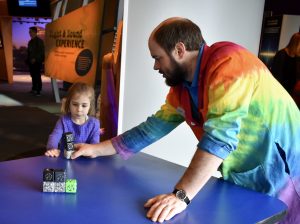Materials to Collect
- Cup
- Markers
- Tape/Hot Glue
- DC Hobby motor
- 1 x AA Battery Holder
- AA battery
- Sheet of Paper
- Wirecutters
Build Your Own
- Gather all of your materials. Some things like the DC motor and the battery holder can be recycled form toys that no longer work. If you do not have one readily available, they can also be purchased online (i.e. Amazon).
- Attach the markers around the cup, either with hot glue or tape. Place the markers in a way that the cup stands up supported by the markers. Make sure that the nib of the markers extends below the rim of the cup when the caps of the markers are removed.
- Attach a “spinner” to the axle of the motor. This can be anything that will hold onto the axle while it spins. A glue stick, clothespin, clay, or even a piece of masking tape are all great options. Attach it off center on the axle with one side longer than the other, think like the hands of a clock.
- Attach the DC motor to the top of the cup with glue or tape, with the axle and spinner extending off the side. Make sure the spinner can rotate freely without hitting the cup or the markers.
- Using glue, attach the battery holder anywhere to the cup that won’t get hit by the spinner.
- The motor has 2 small metal tabs on it. This is where the wires from the battery holder will hook in to. Attach one wire to one metal tab by threading through the hole and bending the wire to stay secure. If your wires from your battery aren’t exposed enough, you may need to strip some of the rubber insulation off by using wire cutters to expose more of the copper wire.
- Take the caps of the marker off, and place the DoodleBot onto your piece of paper.
- Place your battery in the battery holder. This will complete the circuit and your DoodleBot will start dancing around and drawing on your paper! If it doesn’t, check to make sure all wires are connected and your battery is securely in the holder.
What is the Science?
When our battery is placed in the holder and both wires are connected to the motor, the electric circuit is closed. The electricity flowing through this circuit causes the motor’s axle to spin. Since our spinner and motor have a center of mass that is off balance, the motor and everything attached to it wobbles back and forth very fast with every turn. This causes vibrations just like in a cell phone and your DoodleBot jumps around on top of the paper, drawing with the markers that are holding it up.
Ask Your Young Scientists
- How can we turn the DoodleBot off?
- What does the DoodleBot remind you of, where have you seen something like this before?
- How can we change the drawings that our DoodleBot is making?
- What happens when we change the “spinner” on our DoodleBot? Can you find something longer/shorter/heavier/lighter to attach?
More to Explore
Look around the house and see if you can find other things that vibrate. Can you find what is making those vibrations? What are some other things that spin around an axle that you don’t want to vibrate? If you can find another toy to vibrate and dance around, attach the motor and battery to that for some extra fun.
We want to see what you try at home. Share your creation with us by tagging @CTScienceCenter and using the #ScienceAtPlay on social media for a chance to be featured.

Justin Riley is the Teen Programs Coordinator and STEM Educator at the Connecticut Science Center, where he works closely with high school students giving them access to STEM and leadership programming. Justin graduated from the University of Hartford with his Bachelors in Electrical Engineering Technology and a Masters degree in Counselor Education and Student Development. Justin has worked several years with a wide range of students from pre-k to college. His love of engineering and mentoring led him to the Connecticut Science Center where he gets to use his many talents to work and connect with the students in the Greater Hartford area. When he is not helping to run the teen program, he spends his time traveling and spending close time with family and friends.



